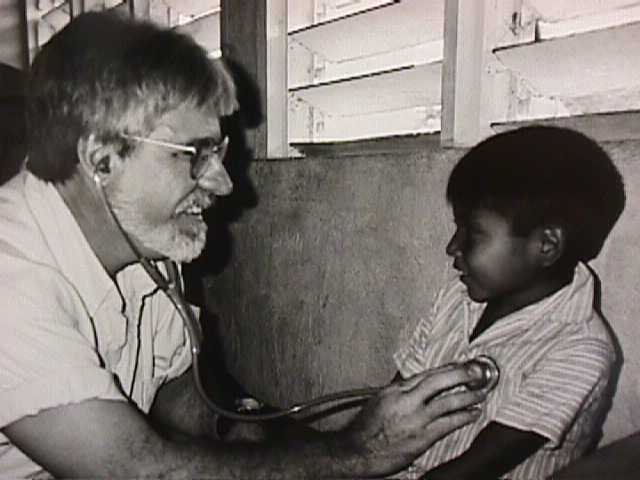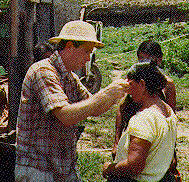Project Belize
- 2004
Front row:
Sarah Fields, Trina Foster, Randall Cardott, Sara Robinson, Caroline Mueller,
Joe Bartnik, Barbara Cordell
Second Row
Right: Steve Whiddon, Carlos Oscar Cal
Third or
top row: Jason Johnson, Bruce McNellie, Quinn Robinson, Tammy Robinson,
Andrea Oliver Kimzey, Robin Sellers, Pam Mueller
May 26, 2004,
Blue Creek Lodge, Toledo District, Belize, Central America
Pictures from
this year's trip.
Dr. Quinn Robinson, Joe Barnik, and Bruce McNellie on the way to Santa Rosa, near the Guatemala and Belize border. The temperature is usually near 100 and the humidity is usually over 90% making for a hot long hike.
Children in Dolores, near the Belize-Guatemalan border waiting to be
seen at the clinic run by Project Belize..
Children just out of school coming in for a check up at one of the clinics
held by Project Belize in Graham Creek, near the southern end of Belize
near Guatemala.
Jason Johnson, one of the student nurses on this year's trip, walking
over one of the many foot bridges on the way to Graham Creek.
Dr. Quinn Robinson, Tammy Robinson, and Joe Barnkik walking accross a foot bridge.
Children on a break in a one room school house in Graham Creek, a village
near the Belize-Guatamalan border.
Children waiting for their turn in the clinic. Most were treated for upper respiratory infections, skin rashes and fungus, and internal parasites, as well as given vitamins. The village is Graham Creek, about a two hour walk from the closest road.
Jason Johnson, student nurse, treating a patient near Crique Jute, Belize.
Marcos Col and his daughter, Elvita, provided the ferry for the
group to cross the river to Crique Sarco on the way to Graham Creek.
The end of a hot and long day. One village visit required a boat ride
accross a river and then a two hour hike to reach it. Student Jason Johnson
and Steve Whiddon, RN. are awaiting the boat.
Robbin Sellers, Dr. Barbara Cordell, and Dr. Randall Cardott working on sorting through medications in a small village near Crique Jute, Belize.
Dr. Barbara Cordell taking history information from a mother
and her infant in San Vicente, Belize.
Andrea Oliver Kimzey, RN, providing treatment to a patient in San Jose, Belize.
Dr. Quinn Robinson and Tammy Robinson, R.N., providing treatment and collecting records for clients in San Jose, Belize.
Caroline Mueller and Sara Robinson, taking a break and teaching some
children the fine art of cards in San Jose, Belize.
Sara Robinson, Bruce McNellie, Tammy Robinson, Quinn Robinson, and Jason Johnson, on top of Temple IV, Tikal National Park, Peten District, Guatemala, Central America. At the end of the work portion of the trip some of the members travel to the island of Ambergis Caye for fishing, swimming, and snorkling and some visit the Mayan ruins at Tikal. This group just climbed this 212 foot high temple, the highest in Central America.
Tammy, Quinn, and Sara Robinson perched on the edge of the top of Temple
IV looking past to the
Jaguar Temple in Tikal National Park at about 6:00 am, May 28, 2004.
Tammy and Sara Robinson with the Temple of the Sun near the plaza and
ball court at Tikal National Park.
Elaine Shippley, Altrusa Club of
Nacogdoches, making a
contribution to Project Belize
representative Bruce McNellie.
Altrusa has been a consistent supporter
of the
medical work of Project Belize.

Evening Lions President, Alma Pippens, making
a donation
to Project Belize representative Bruce McNellie.

Each year Dr. Robert Lehman and his staff code glasses for the trip.
Here Cathy McGough presents glasses to
Project Belize representative, Bruce McNellie
To
more pictures from this year's trip.
Project Belize owes a great deal
to the Altrusa Club, Dr. and Mrs. John Decker, Dr. and Mrs. Robert Carroll,
and Dr. Lehman and his staff for the support they have provided in past
years and for this year. The funds collected go solely to the purchase
of medication carried by the group for the clinics held each year. The
evening Lions Club also donates glasses which are distributed as part of
the clinics held by Project Belize.

